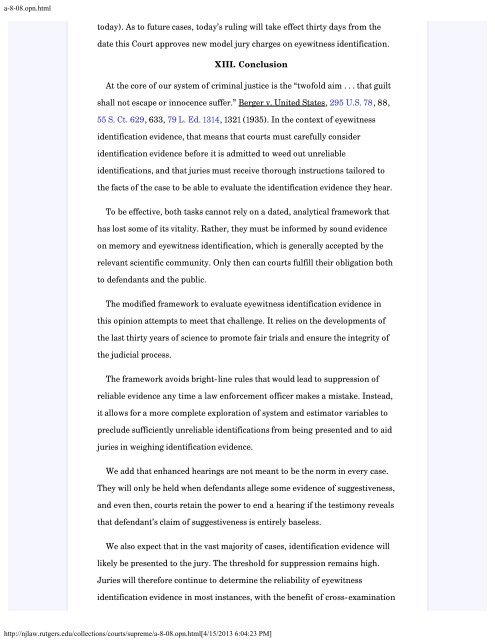State v. Henderson and the New Model Jury Charges - New Jersey ...
State v. Henderson and the New Model Jury Charges - New Jersey ...
State v. Henderson and the New Model Jury Charges - New Jersey ...
You also want an ePaper? Increase the reach of your titles
YUMPU automatically turns print PDFs into web optimized ePapers that Google loves.
a-8-08.opn.html<br />
today). As to future cases, today’s ruling will take effect thirty days from <strong>the</strong><br />
date this Court approves new model jury charges on eyewitness identification.<br />
XIII. Conclusion<br />
At <strong>the</strong> core of our system of criminal justice is <strong>the</strong> “twofold aim . . . that guilt<br />
shall not escape or innocence suffer.” Berger v. United <strong>State</strong>s, 295 U.S. 78, 88,<br />
55 S. Ct. 629, 633, 79 L. Ed. 1314, 1321 (1935). In <strong>the</strong> context of eyewitness<br />
identification evidence, that means that courts must carefully consider<br />
identification evidence before it is admitted to weed out unreliable<br />
identifications, <strong>and</strong> that juries must receive thorough instructions tailored to<br />
<strong>the</strong> facts of <strong>the</strong> case to be able to evaluate <strong>the</strong> identification evidence <strong>the</strong>y hear.<br />
To be effective, both tasks cannot rely on a dated, analytical framework that<br />
has lost some of its vitality. Ra<strong>the</strong>r, <strong>the</strong>y must be informed by sound evidence<br />
on memory <strong>and</strong> eyewitness identification, which is generally accepted by <strong>the</strong><br />
relevant scientific community. Only <strong>the</strong>n can courts fulfill <strong>the</strong>ir obligation both<br />
to defendants <strong>and</strong> <strong>the</strong> public.<br />
The modified framework to evaluate eyewitness identification evidence in<br />
this opinion attempts to meet that challenge. It relies on <strong>the</strong> developments of<br />
<strong>the</strong> last thirty years of science to promote fair trials <strong>and</strong> ensure <strong>the</strong> integrity of<br />
<strong>the</strong> judicial process.<br />
The framework avoids bright-line rules that would lead to suppression of<br />
reliable evidence any time a law enforcement officer makes a mistake. Instead,<br />
it allows for a more complete exploration of system <strong>and</strong> estimator variables to<br />
preclude sufficiently unreliable identifications from being presented <strong>and</strong> to aid<br />
juries in weighing identification evidence.<br />
We add that enhanced hearings are not meant to be <strong>the</strong> norm in every case.<br />
They will only be held when defendants allege some evidence of suggestiveness,<br />
<strong>and</strong> even <strong>the</strong>n, courts retain <strong>the</strong> power to end a hearing if <strong>the</strong> testimony reveals<br />
that defendant’s claim of suggestiveness is entirely baseless.<br />
We also expect that in <strong>the</strong> vast majority of cases, identification evidence will<br />
likely be presented to <strong>the</strong> jury. The threshold for suppression remains high.<br />
Juries will <strong>the</strong>refore continue to determine <strong>the</strong> reliability of eyewitness<br />
identification evidence in most instances, with <strong>the</strong> benefit of cross-examination<br />
http://njlaw.rutgers.edu/collections/courts/supreme/a-8-08.opn.html[4/15/2013 6:04:23 PM]
















